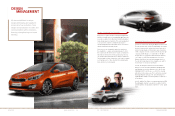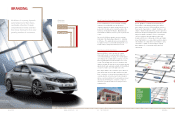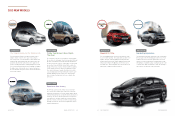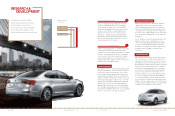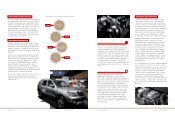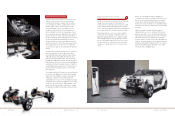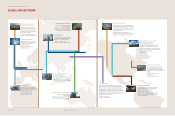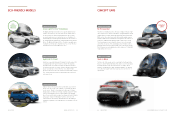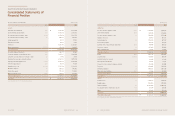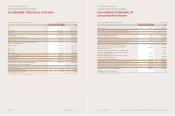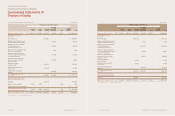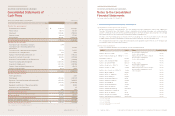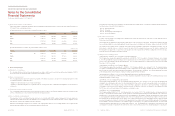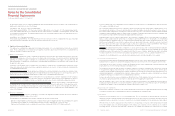Kia 2013 Annual Report Download - page 29
Download and view the complete annual report
Please find page 29 of the 2013 Kia annual report below. You can navigate through the pages in the report by either clicking on the pages listed below, or by using the keyword search tool below to find specific information within the annual report.
A PHEV has a larger capacity battery than an HEV and can
be recharged using a regular home electric socket. When
the battery charge drops below a certain threshold while
the vehicle is being driven, the vehicle moves into hybrid
mode, in which both the engine and the electric motor run,
thus enabling longer journeys. In Kia’s case, we use a 2.0
GDI gasoline-powered engine and a high voltage lithium-
ion polymer battery with an output of more than 50 kW.
This long-distance PHEV will help to further establish Kia’s
credentials in the green car market.
An FCEV is powered by fuel cells that produce electricity
through the chemical reaction between hydrogen and the
oxygen in the air. The only emission from an FCEV is water,
making it a genuinely eco-friendly car that can tackle the
twin challenges of environmental degradation and energy
depletion.
In 2009, we succeeded in developing the Mohave FCEV,
which features a 115 kW fuel cell stack, among the best
in the world, and a next-generation energy storage device
called a super-capacitor. The Mohave FCEV can travel
up to 685 km on a single charge, and has a maximum
speed of 160 km/h. It also satisfies all US collision
safety requirements. The Mohave FCEV’s outstanding
durability and technology were proven with the successful
completion of the 2,655-km US Hydrogen Road Tour 2009
organized by the U.S. Department of Energy.
We have succeeded in localizing 99% of fuel cell system-
related technologies, and we are now focusing on
additional technology development to further increase
system efficiency.
A key aim of next-generation automobile technology is
to increase energy efficiency against a backdrop of the
steady strengthening of fuel economy regulations by
governments across the globe in an effort to tackle climate
change. We are focusing on developing products that offer
maximum energy efficiency by making the engine smaller,
developing continuously variable transmissions, reducing
the weight of the vehicle body, adopting aerodynamic
designs that minimize air resistance, using ultra-low
friction tires, and employing a system that limits idling. We
are applying the results of these efforts across our product
line-up.
Engine downsizing involves decreasing engine
displacement or the number of cylinders in order to
improve fuel economy. But reducing engine displacement
also decreases engine output and torque performance. In
addition, decreasing the number of cylinders may increase
noise and vibration. We are therefore applying direct
injection and turbo technologies to improve performance,
strengthening stiffeners, modifying component structures,
and using various other technologies to ensure a quiet
driving experience. In 2012, we successfully developed
a proprietary CVVL technology that enhances engine
efficiency while maintaining displacement size. We
are focusing on research to expand and enhance the
performance of our diesel line-up, especially with the
emergence of diesel engines as a dominant trend in the
green car market.
The 2012 Ray turbo model uses the Kappa 1.0 turbo
engine and has 36%, 46%, and 5% better maximum
output, torque, and fuel economy, respectively, than its
predecessor. The three-cylinder Kappa engine also emits
less CO2 but boasts higher output than the existing four-
cylinder engine, thanks to a reduction in size and weight.
We made the components lighter for less NVH (Noise,
Vibration and Harshness) while improving their rigidity
to help to deliver a quieter driving experience. Turbo
technology has also been used to enhance performance.
GDI (Gasoline Direct Injection) technology injects fuel
directly into the cylinders for greater fuel efficiency.
When a GDI engine is combined with turbo technology,
it is possible to downsize engines, with displacement
being reduced while performance is enhanced. We have
developed a full line-up of GDI engines for all vehicle
classes, ranging from the Lambda engine for full-sized
vehicles – Kia Quoris/K900 (K9), Cadenza (K7) – and
the Theta engine for mid-sized vehicles – Optima (K5),
Sorento, Sportage – to the Gamma engine for compacts
– Forte/Cerato (K3), Soul. We plan to complete engine
downsizing through the phased expansion of the use of
turbo GDI engines.
A car is powered by the force of the combustion generated
when fuel and air meet. We therefore conduct research
into technologies that enable more effective control of fuel
and air to boost performance and efficiency. Our efforts
to improve fuel injection include reducing the number of
cylinders and developing GDI engines. The technology
used to inject air efficiently, another critical aspect of
powering a car, is dubbed CVVL (Continuous Variable
Valve Lift). In 2012, we developed the Nu CVVL engine by
optimizing air intake, resulting in better performance and
fuel economy. We have since used this engine in the 2013
Optima (K5).



